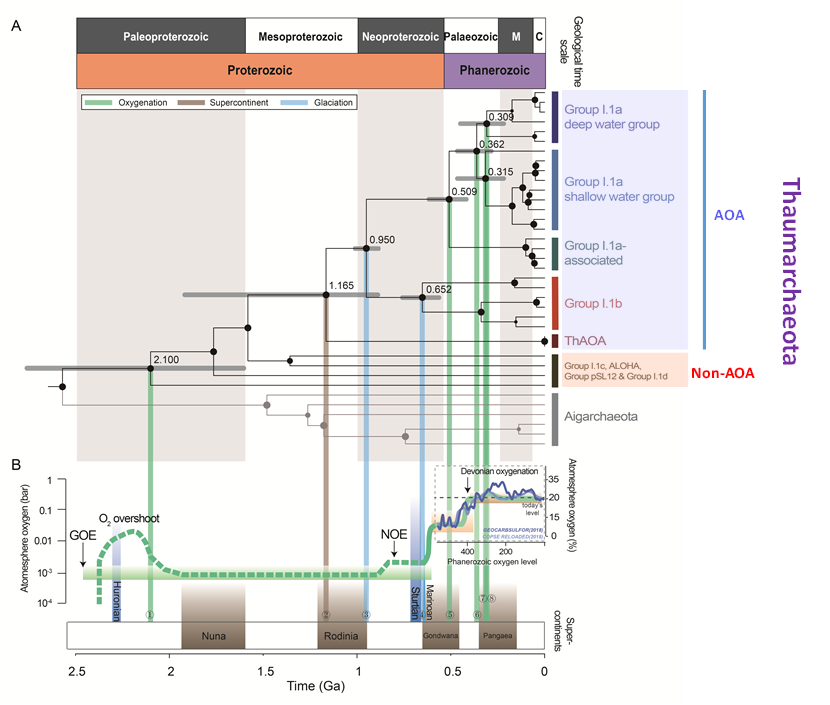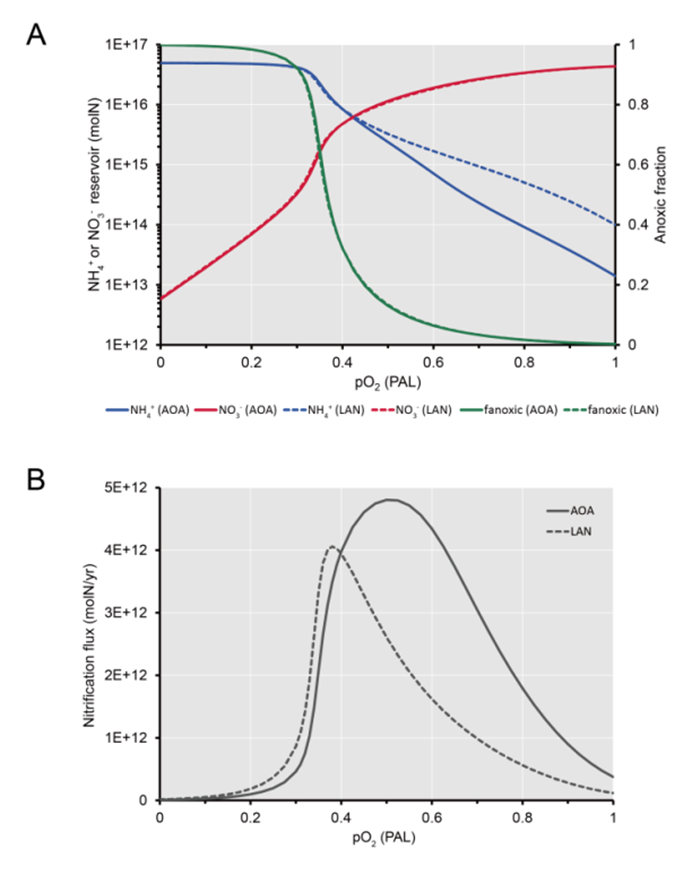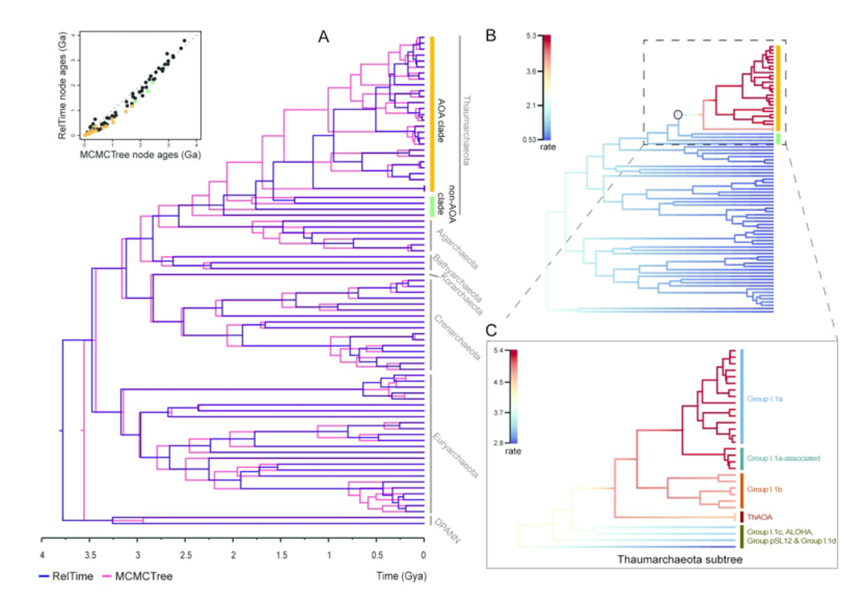Recently, Professor Chuanlun Zhang’s group from the Department of Ocean Science and Engineering (OSE) at the Southern University of Science and Technology (SUSTech) and Professor Zhiwei Cao’s group from Tongji University, made significant progress in microbial and geological co-evolution. Their study, entitled “The evolution pathway of ammonia-oxidizing archaea shaped by major geological events,” was published in the renowned journal Molecular Biology & Evolution. Their work is based on the ‘molecular clock theory’ of evolutionary biology and combines evidence from genomics and geochemistry to explore the microbial evolution in ancient geological time.

Molecular clocks use the substitution rate of heritable biomolecules (such as nucleotide or amino acid sequences) to trace the evolution pathway of life. The calibration of base substitution rates by the fossil record allows the evolutionary history of various macroorganisms to be inferred. The lack of fossils of microorganisms (specifically archaea or bacteria) makes it difficult to find evidence in the geological stratigraphy as a calibration for timing microbial evolution. Thus, the increasing availability of massive genomic data that would allow molecular clock calculations to become more precise is promising, enabling the quantification of microbial evolutionary histories shaped by important geological events on ancient earth.
Nitrogen is an essential element required for life. Nitrification (i.e., the gradual conversion of NH4+ to NO2– and NO3– by microorganisms) is a critical process in the nitrogen cycle and is essential for maintaining ecosystem balance. Scientists have extensively studied nitrification in the Earth using geological methods, but the evolution pathway of the microorganisms involved in nitrification is largely unknown.
Ammonia-oxidizing archaea (AOA) are widely distributed worldwide and are an important contributor to the global nitrogen cycle, especially in nitrification reactions. This paper presents a systematic evolutionary analysis of AOA, revealing the speciation time during the evolutionary process. The results show that ancestors of AOA existed in terrestrial hot spring environments around 1.165 billion years ago, gradually evolving to low-temperature soil environments around 652 million years ago. They entered shallow marine environments around 509 million years ago and rapidly diverged to deep-sea environments around 300 million years ago (Figure 1).

Figure 1. Correlations of key evolutionary time points of AOA with major global events.
Geochemical modeling was used to estimate the fluxes of ammonium (NH4+) and nitrate (NO3–) constrained by atmospheric oxygen concentration (pO2 (PAL)) at different redox states in the ocean (Figure 2). The results corroborated the time point (around 300 million years) when the AOA radiated into the deep sea (Figure 1).

Figure 2. Geochemical modeling of the participation of AOA with high affinity to ammonium and other low-affinity nitrifiers (LAN) in the nitrification process under oxygen-limiting conditions.
The authors used a combined RelTime and MCMCTree analysis method to construct a phylogenetic tree based on the molecular clock model (Figure 3). This method allows a more accurate estimation of the differentiation time of AOA than using the Bayesian algorithm-based MCMCTree alone.

Figure 3. Comparison of the effects of two calculation methods for estimating the divergence time of AOA.
This study reveals the evolution of ammonia-oxidizing archaea from terrestrial hydrothermal environments to deep-sea environments. The key nodes of differentiation of their major taxa coincide with the oxygenation of the Earth’s atmosphere (especially the occurrence of two major oxidation events – GOE and NOE), along with the amalgamation and disassemble of the Rodinia supercontinent (accompanied by global volcanism and glaciation), and the subsequent deep-sea oxidation events (Figure 4).
Their research integrated evolutionary biology, geology, geochemistry, and numerical modeling to simulate the co-evolutionary history of ancient microbes and the Earth system. As a result, it’s expected to further improve the accuracy of time-point analysis of microbial evolution and facilitate the exploration of life evolution in the ancient geological time when the physical fossil record has been primarily obviated.

Figure 4. Schematic diagram of the gradual evolution of AOA from terrestrial hydrothermal environments to deep-sea environments.
Professor Chuanlun Zhang from OSE at SUSTech and Yiyan Yang, a Ph.D. student from Tongji University, are the co-first authors of this paper. Professor Chuanlun Zhang is also the co-corresponding author, alongside Professor Zhiwei Cao from Tongji University. Professor Maoyan Zhu from the Nanjing Institute of Geology and Paleontology, Chinese Academy of Sciences (NIGPAS), also made significant contributions studying the coupling of geological events and AOA evolution.
Professor Timothy Lenton performed the geochemical modeling, while other co-authors contributed to data collection, analysis, and editing of the paper. A special mention also goes to Wei Xie, Qiqing Tao, Jie Yang, Wei Qin, Zhengshuang Hua, Zunli Lu, Yan-an Shen, Brian Hedlund, Marike Palmer, and Bill Scholf for their help and support during the writing and revision of this paper.
Paper link: https://academic.oup.com/mbe/advance-article/doi/10.1093/molbev/msab129/6276452
Proofread ByAdrian Cremin, Yingying XIA
Photo By